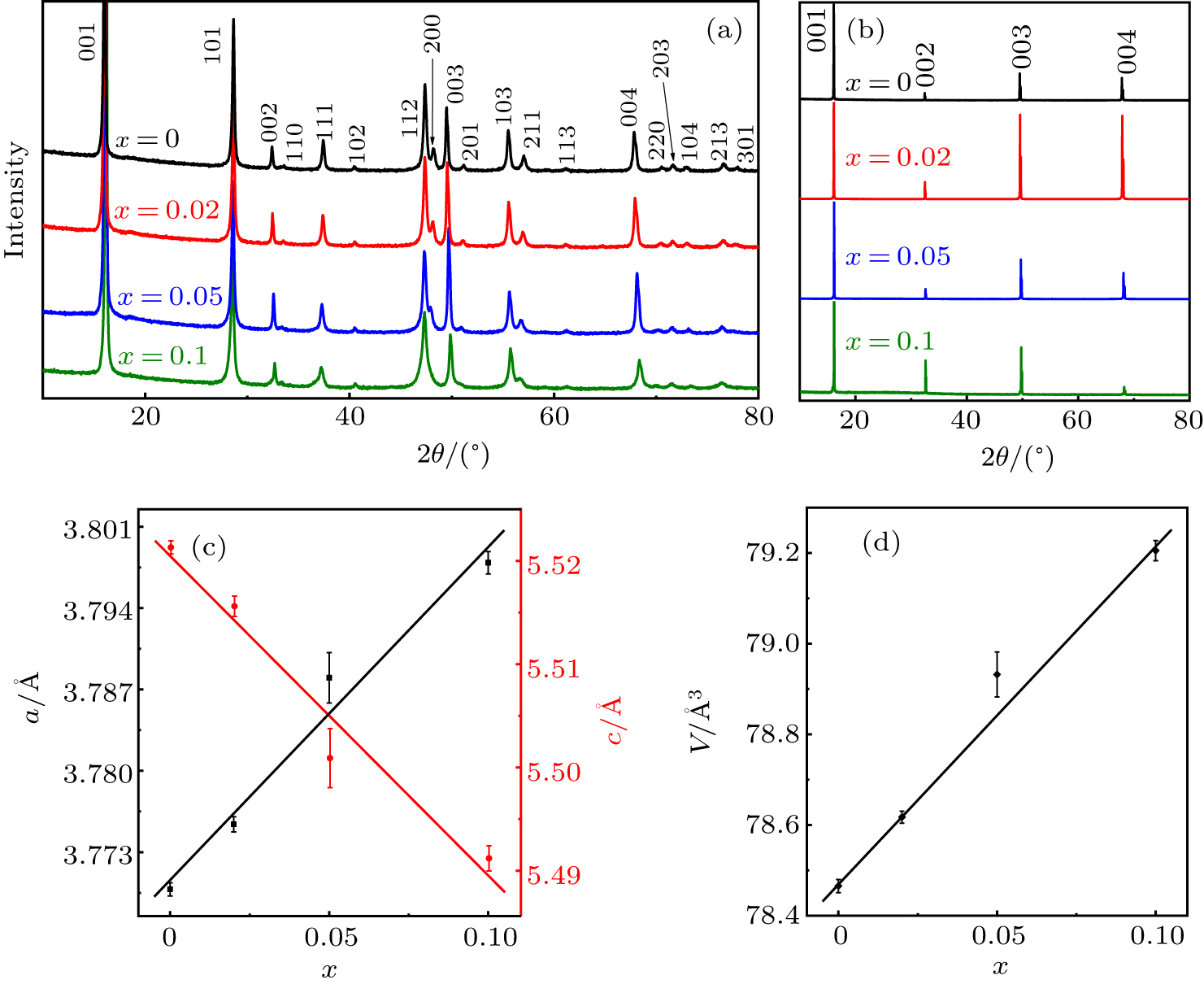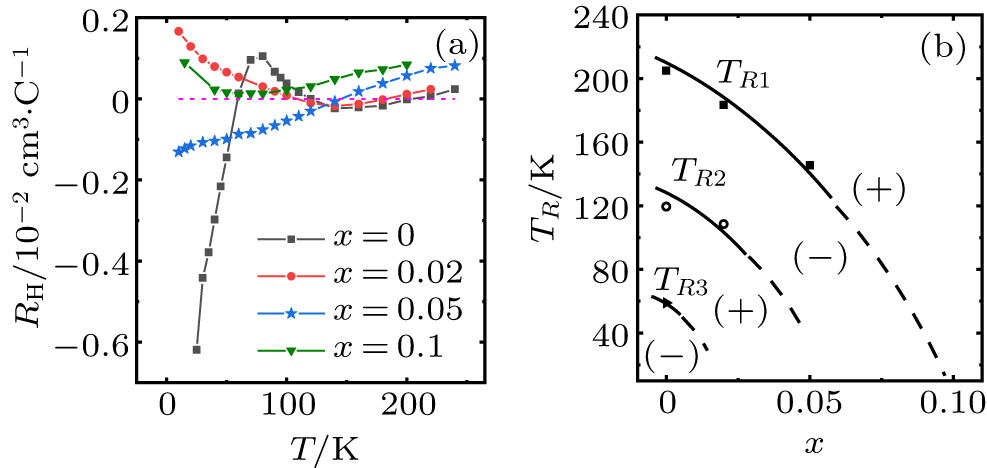Abstract
We report the structural and electrical transport properties of Fe1–xCuxSe (x = 0, 0.02, 0.05, 0.10) single crystals grown by a chemical vapor transport method. Substituting Cu for Fe suppresses both the nematicity and superconductivity of FeSe single crystal, and provokes a metal–insulator transition. Our Hall measurements show that the Cu substitution also changes an electron dominance at low temperature of un-doped FeSe to a hole dominance of Cu-doped Fe1–xCuxSe at x = 0.02 and 0.1, and reduces the sign-change temperature (TR) of the Hall coefficient (RH).
Export citation and abstract BibTeX RIS
1. Introduction
The structurally simplest FeSe exhibits distinctive normal-state properties among the iron-based superconductors and is therefore important for investigating the underlying physics of the superconductivity.[1] Its superconducting transition temperature TC = 8 K at ambient pressure,[2] which can be raised to 37 K by high pressure of 8 GPa,[3] to ∼ 40 K by alkali-metal[4–7] or small molecule intercalation,[8,9] and even above 65 K in one-unit-cell film on SrTiO3.[10] FeSe undergoes a nematic transition at Ts = 90 K which is rapidly suppressed by pressure and can be tuned continuously by isoelectronic S or Te substitution at Se site of FeSe.[11–13] Furthermore, with increasing pressure, the low-TC superconducting phase transforms into the high-TC phase, where the normal-state Hall resistivity changes sign from negative to positive, demonstrating a hole dominance in contrast to other FeSe-derived high-TC systems.[14] Recently, the observation of non-Fermi liquid property in FeSe1 – x Sx and the topological nature of FeSe1 – x Tex have triggered renewed interest.[15,16] Besides isoelectronic S and Te substitution at Se site, transition elements substitution at Fe site of FeSe would be also of interest for their comparable ionic sizes to Fe and the potential to tune the carrier type and concentration or investigate magnetic or non-magnetic impurity effect on superconductivity.[17–24]
Earlier studies of Cu-substituted FeSe powder samples show that Cu substitution at Fe site in FeSe suppresses superconductivity and provokes a metal–insulator transition.[21,22] Under a relatively small pressure of 1.5 GPa, superconductivity in Cu0.04Fe0.97Se is restored below 6.6 K; and TC is increased to its maximum of 31.3 K upon an applied pressure at 7.8 GPa.[23] Detailed Mössbauer spectroscopy studies on the 57Fe-enriched Cu0.04Fe0.97Se powder sample reveal that part of the iron sites are magnetically ordered at low temperature, and the static magnetic moments destroy the superconducting pairing. Raising pressure leads to a collapse of the static magnetism and restoration of superconductivity with the maximal TC value at 8 GPa.[24] In contrast to the extensive studies on the intrinsic properties of isoelectronically substituted FeSe1 – x Sx and FeSe1 – x Tex due to the availability of high-quality single crystals,[1] few study of transition elements substitution effect is reported in FeSe single crystals. In the present paper, we report the structural and electrical transport properties of Fe1–x Cux Se (x = 0–0.10) single crystals. Cu substitution suppresses both the nematicity and superconductivity of the FeSe single crystal, provokes a metal–insulator transition, changes an electron dominance at low temperature of un-doped FeSe to a hole dominance of Cu-doped Fe1–x Cux Se at x = 0.02 and 0.1, and reduces the sign-change temperature (TR ) of the Hall coefficient (RH).
2. Experiments
A series of Fe1–x Cux Se (x = 0, 0.02, 0.05, 0.10) single crystals were grown by a chemical vapor transport method, using high-purity Fe, Cu, Se powders as raw materials and mixture of AlCl3 and KCl as transport agent.[25] The temperature of the hot and cold positions was kept at 400 °C and 350 °C, respectively. After a duration of 30 days, single crystals with a size of 3–5 mm were grown around the cold part of the quartz tube. The experimental details are given in Table 1.
Table 1. Experimental details for growing Fe1–x Cux Se single crystals.
| Nominal composition | Transport agent mole ratio | Thot – Tcold | Actual composition |
|---|---|---|---|
| FeSe0.94 | AlCl3:KCl = 3:1 | 400 °C–350 °C | FeSe |
| Fe0.95Cu0.05Se0.94 | AlCl3:KCl = 3:1 | 400 °C–350 °C | Fe0.98Cu0.02Se |
| Fe0.9Cu0.1Se0.94 | AlCl3:KCl = 3:1 | 400 °C–350 °C | Fe0.95Cu0.05Se |
| Fe0.8Cu0.2Se0.94 | AlCl3:KCl = 3:1 | 400 °C–350 °C | Fe0.9Cu0.1Se |
The actual chemical composition of Fe1–x Cux Se single crystals was determined by inductively coupled plasma atomic emission spectroscopy. The x-ray diffraction (XRD) measurements were performed on the x-ray diffractometer (MXP18A-HF) used copper Kα radiation. Electrical transport measurements up to 9 T were performed on a Quantum Design PPMS-9 system.
3. Results and Discussion
The results of powder XRD at room temperature demonstrate that the Fe1–x Cux Se single crystals are of single phase and all the diffraction peaks can be well indexed with a previously reported tetragonal structure,[21,22] as shown in Fig. 1(a). Figure 1(b) shows the single crystal XRD patterns for all the Fe1–x Cux Se (x = 0, 0.02, 0.05, 0.10) single crystals. Only (0 0 l) reflections are observed, indicating that the single crystals are in perfect (0 0 1) orientation. Figure 1(c) shows the lattice parameters a and c as functions of the Cu doping level. With increasing Cu content, the lattice parameter a increases monotonically, while c decreases monotonically, consistent with previous reports.[21,22] As displayed in Fig. 1(d), the unit cell volume V = a2 c increases linearly with increasing Cu content.
Fig. 1. (a) Powder XRD patterns for Fe1–x Cux Se. (b) Single crystal XRD for Fe1–x Cux Se. (c) Variation of refined lattice parameters a and c with Cu doping level x. (d) Variation of unit cell volume V = a2 c with Cu doping level x.
Download figure:
Standard imageFigure 2 shows the temperature dependence of the normalized electrical resistivity ρ (T)/ρ (300 K) and specific heat measured for Fe1–x Cux Se (x = 0, 0.02, 0.05, 0.10) single crystals. Pure FeSe is superconducting at TC = 8.3 K and the kink at Ts = 90 K in the resistivity curve represents the nematic transition, which is more clearly visible from a dip in the temperature derivative of the resistivity as shown in the inset of Fig. 2(a) and a jump in the specific heat as displayed in Fig. 2(b). A small Cu doping of 2% can completely suppress the superconductivity and nematicity, as no such kink and jump can be found in the resistivity and specific heat measurements, respectively [Figs. 2(a) and 2(b)]. While the resistivity of FeSe in the normal state demonstrates a metallic behavior, an upturn with decreasing temperature appears around 42 K in the resistivity of Fe0.98Cu0.02Se, indicating a transition behavior from metallic to semiconducting with Cu doping. At Cu doping level x = 0.05 and 0.10, the resistivity increases quickly with cooling, showing an insulating behavior in the whole temperature range, which is in agreement with previous results of powder sample. The metal–insulator transition in Fe1–x Cux Se can be probably attributed to Anderson localization arising from disorder.[26,27]
Fig. 2. (a) Temperature dependence of the normalized resistivity ρ(T)/ρ (300 K) in Fe1–x Cux Se. Inset shows the temperature dependence of the first derivative of resistivity for FeSe. (b) Specific heat measurement displayed by the Cp/T versus T plots for Fe1–x Cux Se.
Download figure:
Standard imageTo further investigate the effects of Cu doping on the electrical transport properties, we measured the Hall effect of Fe1–x Cux Se (x = 0, 0.02, 0.05, 0.10) single crystals. Figure 3 shows the Hall resistivity ρxy at various temperatures with different Cu doping level. As seen in Fig. 3(a), ρxy of stoichiometric FeSe shows a linear field dependence for T > 50 K, in accordance with the compensated semimetal character, and the slope changes sign twice from positive to negative and then back to positive upon cooling.[28] A non-linearity develops for ρxy and the initial slope eventually becomes negative for T ≤ 50 K, but tends to change sign again under higher magnetic field. Unlike pure FeSe, the common feature of ρxy curves for Fe1–x Cux Se with x = 0.02, 0.05, 0.1 is that no non-linearity develops in the whole temperature and magnetic field range. For Fe0.98Cu0.02Se as shown in Fig. 3(b), the slope changes sign twice from positive to negative and then back to positive and remains positive upon cooling to 10 K. For Fe0.95Cu0.05Se as displayed in Fig. 3(c), the slope changes sign once from positive to negative at T = 140 K. For Fe0.90Cu0.10Se, the slope always remains positive in the whole temperature range without any sign change as presented in Fig. 3(d).
Fig. 3. Magnetic field (H) dependence of Hall resistivity (ρxy ) of Fe1–x Cux Se with x = 0 (a), 0.02 (b), 0.05 (c), and 0.1 (d) in the temperature range from 30 K to room temperature.
Download figure:
Standard imageWe plot in Fig. 4(a) the temperature dependence of the Hall coefficient, defined as the field derivative of ρxy , RH ≡ d ρxy /d H, at the zero-field limit. The sign of the Hall coefficient RH is an indicator of the dominant carrier type. The temperature dependence of RH is shown in Fig. 4(a). With cooling, the Hall coefficient of FeSe changes sign at three temperatures TR1, TR2, and TR3, from positive to negative at TR1 = 205 K, then from negative to positive at TR2 = 120 K with a moderate enhancement of RH before Ts, and finally reversed again at TR3 = 59 K, exhibiting a tendency to strongly negative values below Ts. The evolution with Cu doping of the sign-change temperature TR of the Hall coefficient is summarized in Fig. 4(b). All the three temperatures TR1, TR2, and TR3 are gradually reduced with Cu doping, with TR1 tending to vanish towards Cu doping x = 0.1, which indicates a hole dominant carrier type.
Fig. 4. (a) Temperature dependence of Hall coefficient (RH) of Fe1–x Cux Se with x = 0, 0.02, 0.05, and 0.1 estimated by RH ≡ dρxy /d H, at the zero-field limit. (b) The suppression of the sign change temperature TR of RH with Cu doping level x. The solid and dotted curves are guides to the eyes.
Download figure:
Standard imageAs we know, the valence state of the Fe atom in FeSe and other iron-based superconductors is assigned as Fe2+, so the Fe atoms are formally in the 3d6 electronic configuration. Also, electronic structure calculations for SrCu2As2 and BaCu2As2 predicted that the Cu atoms have a formal valence state of Cu1 + and a nonmagnetic and chemically inert 3d10 electronic configuration.[29] Anand et al. confirmed this result by measuring the electronic and magnetic properties of SrCu2As2 and BaCu2As2, suggesting that Cu substitution for Fe in (Ca,Sr,Ba)(Fe1–x Cux )2As2 should result in hole doping.[30] We infer that Cu substitution in FeSe plays a role of hole doping which leads to the suppression of sign change temperatures TR1, TR2, and TR3 of the Hall coefficient and hole dominant carrier type in Fe1–x Cux Se.
4. Conclusion
We have successfully grown a series of Fe1–x Cux Se single crystals with x = 0, 0.02, 0.05, and 0.1. With increasing Cu doping content, the lattice parameter a increases monotonically, while the lattice parameter c decreases monotonically. Both the resistivity and specific heat measurements indicate that Cu doping suppresses nematicity and superconductivity and provokes a metal–insulator transition in Fe1–x Cux Se. Also, Cu substitution changes an electron dominance at low temperature of un-doped FeSe to a hole dominance of Cu-doped Fe1–x Cux Se at x = 0.02 and 0.1, and reduces the sign-change temperature (TR ) of the Hall coefficient (RH).
Footnotes
- *
Project supported by the National Key Research and Development of China (Grant No. 2018YFA0704200), the National Natural Science Foundation of China (Grant No. 11834016), and the Strategic Priority Research Program of Chinese Academy of Sciences (Grant No. XDB25000000).




